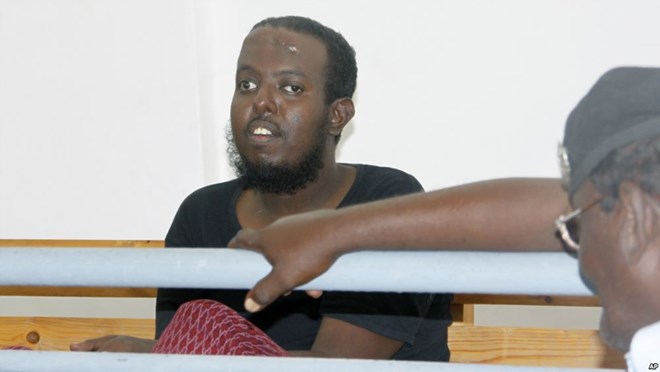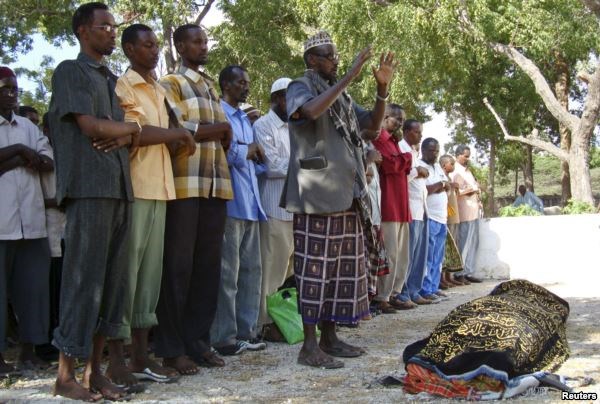
Saturday April 16, 2016
By Mohamed Olad Hassan

Hassan Hanafi Haji sits inside Mogadishu's military court during a hearing on the killings of Somali journalists, in Mogadishu, Somalia, March, 3, 2016.
How does a Somali radio reporter become a spy and collaborator with al-Shabab?Former journalist Hassan Hanafi Haji was executed by a Mogadishu firing squad Monday for his role in the murders of five colleagues as part of an al-Shabab campaign to control local media coverage of the Islamist extremist group.
One of Hanafi’s first targets was the popular private radio station Horn Afrik.“He was a risk living among us,” said reporter Falastin Iman, who woke to gunfire one August morning in 2007 to find Horn Afrik colleague Mahad Mohamed Elmi shot dead outside her door.
When they took Elmi’s body to the hospital, Hanafi was waiting there.
“He was there to make sure the situation of Mahad, if he died or if he is alive,” Iman said. “He was very dangerous for the journalists because he knew us. He was not like the other al-Shabab members.”
Hanafi went to Elmi’s burial later that day. In a televised confession that he later said had been obtained through torture, Hanafi said he was at the funeral to identify the car used by Iman and Horn Afrik director Ali Iman Sharmarke.
Roadside blast
Leaving the ceremony, their car was hit by a roadside bomb. Sharmarke was killed. Iman took shrapnel to her head.
“When my superiors are not happy with a journalist, they would call me and ask me about that particular journalist,” Hanafi told Somali state television. “I would provide the information. Sometimes they would inform me who is the next journalist to target and sometimes not.”
Tracing Hanafi’s path from radio reporter to al-Shabab agent, VOA spoke with many of his former colleagues, including Liban Abdi Ali, who first worked with Hanafi at Radio Voice of the Quran.
“The man I knew was very social who liked taking good times with his friends,” Ali recalled. The changes began, he said, when Hanafi started covering Sharia courts and became “a different man, violent, full of hatred and libelous statements against journalists, especially his former friends.”
“Some of his colleagues tried to deradicalize him,” Ali said, “but he was a hard-liner and went too far into the ideology. He believed to die for it.”
Reporter Abdirahman Yusuf al-Adala was Hanafi’s roommate. As his colleague became more radical, al-Adala said, Hanafi “was always calling me, either threatening me or telling me about how they executed other journalists." Al-Adala said Hanafi sought "to terrorize me with sarcastic words over the death of colleagues.”

A Muslim sheikh leads prayers for slain journalist Sa'id Tahlil Ahmed, head of private media house Horn Afrik in Mogadishu, Feb. 5, 2009. Gunmen shot Ahmed in Mogadishu's Bakara market, which is often a battleground for government soldiers and Islamist insurgents, witnesses and colleagues said.
When Hanafi invited reporters to a February 2009 news conference, al-Shabab gunmen killed then-Horn Afrik director Sa’id Tahlil Ahmed en route.“We watched him die in front of us,” al-Adala said. “Hanafi knew about the assassination and facilitated it. That was the day I realized that my former colleague was ruthless with inhuman intentions.”
Sarcastic calls
Even after al-Adala joined government-run Radio Mogadishu because it was protected by African Union peacekeepers, he said Hanafi “was always calling me minutes after the killing of a journalist in Mogadishu, sarcastically saying, ‘So-and-so has tasted the punishment of the mujahedeen.’ ”
Now the director of Somalia’s government news agency, al-Adala said Hanafi was “the biggest threat to my life, while I was unaware of it.”
Ahmed Abdirahman Jaakat stepped in to lead Horn Afrik programming after the deaths of the station’s two previous directors. He said Hanafi ordered him to play an al-Shabab cassette. When Jaakat refused, the cellphone death threats began.
“They said, ‘If you do not give up what you are doing, you will follow the steps of your friends,' which apparently meant my colleagues whom they murdered and I buried with my hands,” Jaakat said. He fled Mogadishu for Minnesota.
Al-Shabab’s campaign of intimidation resulted in considerable self-censorship among Somali reporters, especially when it came to reporting the group’s military setbacks, said Nairobi-based political analyst Abdiwahab Sheikh Abdisamad.
He said targeting journalists was a tactic to reinforce al-Shabab's aura of unstoppability. He said their messages usually made a point along the lines of: "We are relevant. We can come to any corner of the town. We can target any individual in the town and we can inflict any casualty on society.”
Double trouble
For Falastin Iman, the message was twofold: “I am a female journalist, so I am a threat twice,” she said.

Hassan Hanafi Haji is tied to a wooden post as he is prepared to be executed by firing squad at a police academy in the capital Mogadishu, Somalia Monday, April 11, 2016.
Iman, who now reports for VOA’s Somali service, said Hanafi and al-Shabab worked “to intimidate journalists to show the other journalists that, ‘We will do the same to you as we did to this group, so you have to follow our orders.’ They wanted to control our daily editorial events, our news, our programs.”After his capture in Kenya in 2014, Hanafi was one of the few al-Shabab suspects to face prosecution by the Somali government following years of criticism by human rights groups that authorities needed to do more.
The Committee to Protect Journalists said Somalia is one of the world’s most dangerous countries for reporters. The group has recorded 59 killings of journalists in the Horn of Africa country since 1992, the vast majority in the past 10 years.
Hanafi’s execution came days after two other al-Shabab militants were executed for killing a journalist with a car bomb last year. That reporter was the widow of another journalist killed in Mogadishu in 2012.